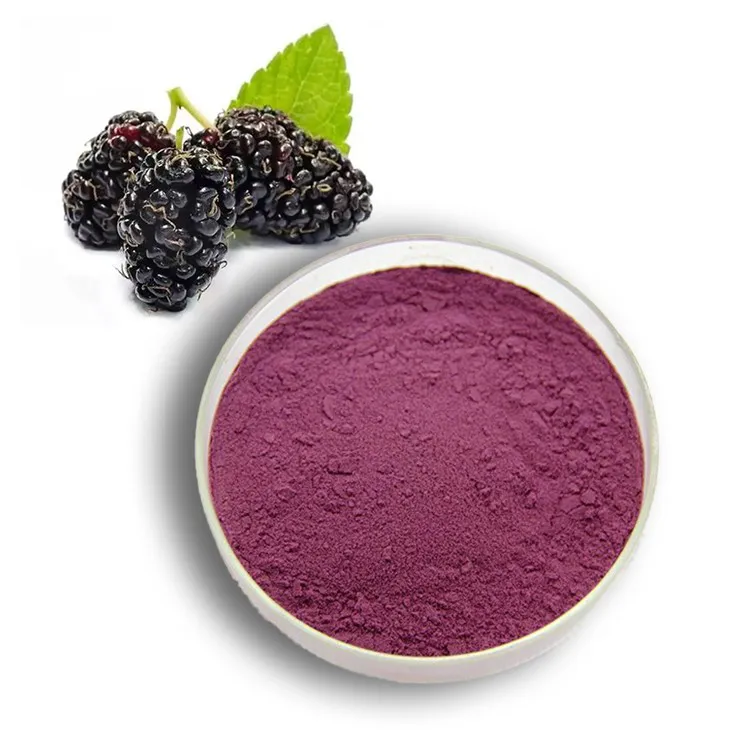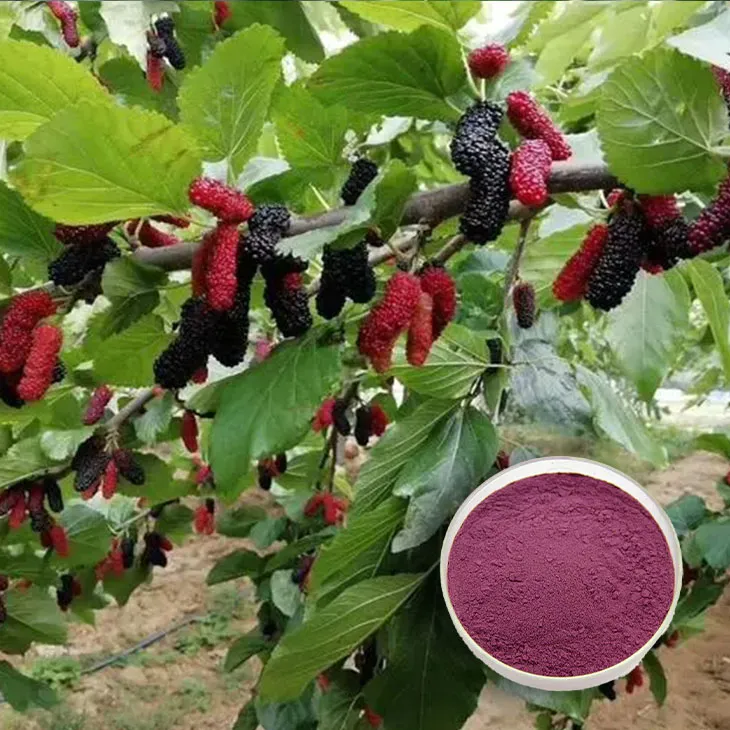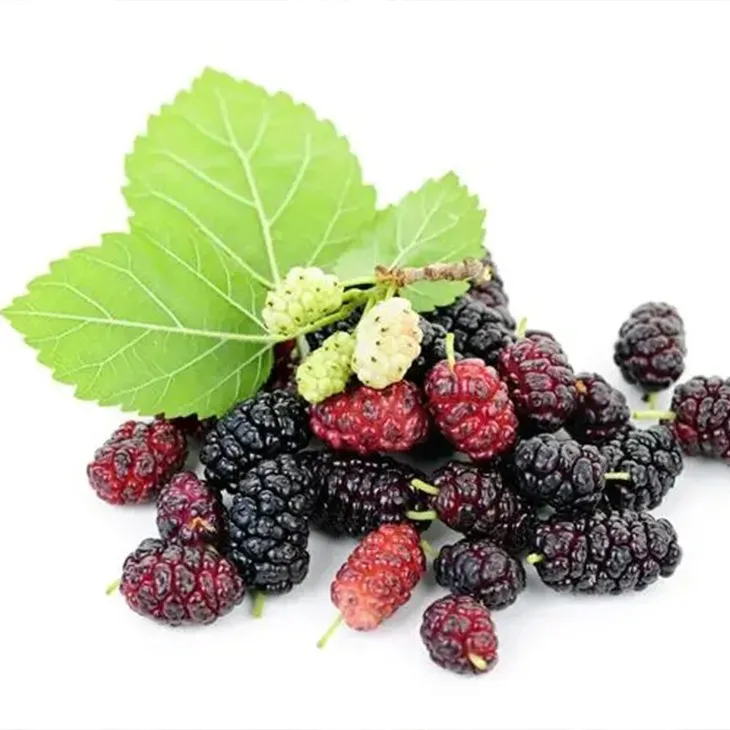- 0086-571-85302990
- sales@greenskybio.com
How to extract mulberry extract from plants?
2024-11-28

1. Introduction
Mulberries are rich in various bioactive components, making the extraction of Mulberry Extract a topic of great interest. The obtained Mulberry Extract can be used in the fields of medicine, cosmetics, and food. Sang - shen extract, which is derived from mulberries, has a wide range of potential applications. Understanding the proper extraction methods is crucial for obtaining high - quality extracts.

2. Raw Material Selection
Fresh and healthy mulberries are the basis for a good extraction. When collecting mulberries, several factors need to be considered:
2.1 Maturity
- Mulberries at the appropriate maturity level should be selected. Over - ripe mulberries may have started to decompose, while unripe ones may not contain the full complement of desired components.
2.2 Purity
- The mulberries should be free from contaminants such as pesticides, dirt, and other foreign substances. Washing the mulberries thoroughly before extraction is often necessary to ensure purity.

3. Soxhlet Extraction
Soxhlet extraction is a well - established and traditional yet effective method for extracting Mulberry Extract.
3.1 Principle
- In this method, the mulberries are placed in a Soxhlet apparatus. A suitable solvent is continuously circulated through the apparatus. The solvent extracts the components from the mulberries over time. The Soxhlet extraction process is based on the principle of repeated extraction with a small amount of solvent, which helps to ensure a relatively complete extraction of the target components.
3.2 Solvent Selection
- The choice of solvent is crucial in Soxhlet extraction. Commonly used solvents include ethanol, methanol, and water. - Ethanol is often a preferred solvent due to its ability to dissolve a wide range of bioactive compounds present in mulberries, such as flavonoids and phenolic acids. It also has the advantage of being relatively safe and easy to handle compared to some other solvents. - Water can also be used as a solvent, especially when the target is to extract water - soluble components. However, water - based extraction may also extract more impurities compared to organic solvents.
3.3 Procedure
- First, the mulberries are dried and ground into a fine powder. This increases the surface area available for extraction. - The ground mulberry powder is then placed in a Soxhlet thimble inside the Soxhlet apparatus. - The chosen solvent is added to the Soxhlet flask. - The apparatus is then heated, and the solvent starts to vaporize. The vapor rises and condenses in the condenser, and the condensed solvent drips back onto the mulberry powder in the thimble. This cycle of vaporization, condensation, and dripping continues for a certain period, usually several hours to days depending on the nature of the components to be extracted. - After the extraction is complete, the solvent containing the extracted components (the extract) is collected from the Soxhlet flask.

4. Centrifugation
Centrifugation can be used to accelerate the separation of the extract from the plant debris after Soxhlet extraction or other extraction methods.
4.1 Working Principle
- Centrifugation works on the principle of sedimentation. When the extract - containing solution is placed in a centrifuge tube and spun at high speeds, the denser plant debris will be forced to the bottom of the tube, while the extract, which is usually less dense, will remain in the supernatant.
4.2 Operational Steps
- Transfer the extract - containing solution from the Soxhlet flask or other extraction vessels into centrifuge tubes. Make sure not to overfill the tubes. - Place the centrifuge tubes in the centrifuge, and balance the tubes properly to ensure the centrifuge runs smoothly. - Set the appropriate centrifuge speed and time. For mulberry extract, a speed of around 3000 - 5000 rpm for 10 - 20 minutes is often sufficient, but this may vary depending on the specific equipment and the nature of the extract. - After centrifugation, carefully decant the supernatant (the extract) into a clean container, leaving the plant debris at the bottom of the centrifuge tube.
5. Enzymatic Hydrolysis in Combination with Extraction
Enzymatic hydrolysis can be combined with extraction to break down cell walls and release more intracellular components, thereby enhancing the extraction efficiency.
5.1 Enzyme Selection
- Cellulase is often a suitable enzyme for mulberry extraction. Mulberry cell walls contain cellulose, and cellulase can specifically break down cellulose, making it easier for the solvent to access the intracellular components. - Pectinase can also be used, especially when the goal is to break down pectin in the cell walls. Pectin is another component that can limit the extraction of intracellular substances.
5.2 Procedure
- First, the mulberries are mixed with the selected enzyme in an appropriate buffer solution. The buffer solution helps to maintain the optimal pH for the enzyme activity. For example, cellulase usually works well at a slightly acidic pH. - The enzyme - mulberry mixture is then incubated at a suitable temperature for a certain period. For most enzymes, a temperature range of 30 - 50 °C is common, and the incubation time can range from 1 - 3 hours depending on the enzyme concentration and the nature of the mulberries. - After enzymatic hydrolysis, the mixture can be subjected to the normal extraction process, such as Soxhlet extraction or other solvent - based extraction methods.
6. Chemical Composition Analysis during Extraction
Analyzing the chemical composition of the extract at different stages helps in optimizing the extraction process for obtaining high - quality sang - shen extract.
6.1 Importance of Analysis
- By analyzing the chemical composition, we can determine whether the target components are being effectively extracted. For example, if the goal is to extract flavonoids, we can use spectrophotometric methods to measure the flavonoid content at different extraction stages. - It also helps in identifying any potential impurities that may be co - extracted. If there are too many impurities, we can adjust the extraction process, such as changing the solvent or extraction conditions.
6.2 Analytical Methods
- Spectrophotometry is a commonly used method. For flavonoids, for example, the reaction with aluminum chloride can produce a colored complex, and the absorbance of this complex can be measured at a specific wavelength to determine the flavonoid content. - High - performance liquid chromatography (HPLC) is a more advanced method. It can separate and quantify different components in the extract with high precision. HPLC can be used to analyze the phenolic acids, flavonoids, and other bioactive compounds in the mulberry extract. - Gas chromatography - mass spectrometry (GC - MS) can be used for analyzing volatile components in the mulberry extract. This method is especially useful when studying the aroma - related components in the extract.
7. Conclusion
In conclusion, the extraction of mulberry extract is a complex process that involves multiple steps and techniques. Starting from the careful selection of raw materials, through traditional extraction methods like Soxhlet extraction, the use of techniques such as centrifugation to separate the extract, the combination of enzymatic hydrolysis to enhance extraction efficiency, and the analysis of chemical composition to optimize the process, each step plays an important role in obtaining high - quality sang - shen extract. Continued research in this area will further improve the extraction methods and expand the potential applications of mulberry extract in various industries.
FAQ:
What are the main solvents used in Soxhlet extraction for mulberry extract?
Common solvents used in Soxhlet extraction for mulberry extract can include ethanol. Ethanol is a popular choice as it is relatively safe, can dissolve a wide range of bioactive compounds present in mulberries, and is easy to handle and remove after the extraction process. Another possible solvent could be methanol, which also has good solubility properties for many plant - based compounds, but it is more toxic than ethanol and requires more careful handling.
How does enzymatic hydrolysis enhance the extraction of mulberry extract?
Enzymatic hydrolysis enhances the extraction of mulberry extract by breaking down the cell walls of the plant cells. Mulberry cells have complex cell walls that can limit the release of intracellular components. Enzymes are specific in their action. For example, cellulase can break down cellulose, a major component of plant cell walls. By degrading the cell walls, the intracellular components, which may contain valuable bioactive substances like polyphenols and flavonoids, are more easily released into the extraction solvent, thus increasing the yield and quality of the mulberry extract.
What factors should be considered when choosing mulberries for extraction?
When choosing mulberries for extraction, several factors should be considered. Firstly, the freshness of the mulberries is crucial. Fresh mulberries are more likely to contain higher levels of bioactive compounds. Secondly, the health of the plants from which the mulberries are sourced matters. Mulberries from healthy plants are less likely to be contaminated with pesticides or affected by diseases, which could impact the quality of the extract. Additionally, the ripeness of the mulberries can also affect the extraction. Ripe mulberries may have different chemical compositions compared to unripe ones, and the desired compounds for extraction may be more abundant in appropriately ripened mulberries.
How can we ensure the quality of the mulberry extract during the extraction process?
To ensure the quality of the mulberry extract during the extraction process, several steps can be taken. Firstly, proper handling and storage of the mulberries before extraction are important to prevent spoilage and degradation of the components. During the extraction, accurate control of parameters such as temperature, extraction time, and solvent - to - sample ratio is necessary. For example, too high a temperature may cause the degradation of some heat - sensitive compounds. Monitoring the extraction process at different stages, for example, by analyzing the chemical composition of intermediate extracts, can also help in ensuring that the extraction is proceeding optimally. After extraction, proper purification and concentration steps should be carried out to obtain a high - quality extract.
What are the potential applications of mulberry extract?
Mulberry extract has several potential applications. In the food industry, it can be used as a natural antioxidant, flavor enhancer, or colorant. Its antioxidant properties can help in preventing the oxidation of fats and oils in food products, thereby increasing their shelf - life. In the pharmaceutical and nutraceutical fields, mulberry extract may contain compounds with potential health benefits such as anti - inflammatory, anti - diabetic, and anti - cancer properties. It can be used in the formulation of dietary supplements or drugs. Additionally, in the cosmetic industry, the extract may be used in skin - care products due to its antioxidant and potential anti - aging properties.
Related literature
TAGS:- ▶ Hesperidin
- ▶ citrus bioflavonoids
- ▶ plant extract
- ▶ lycopene
- ▶ Diosmin
- ▶ Grape seed extract
- ▶ Sea buckthorn Juice Powder
- ▶ Beetroot powder
- ▶ Hops Extract
- ▶ Artichoke Extract
- ▶ Reishi mushroom extract
- ▶ Astaxanthin
- ▶ Green Tea Extract
- ▶ Curcumin Extract
- ▶ Horse Chestnut Extract
- ▶ Other Problems
- ▶ Boswellia Serrata Extract
- ▶ Resveratrol Extract
- ▶ Marigold Extract
- ▶ Grape Leaf Extract
- ▶ blog3
- ▶ blog4
-
Standard - process green tea extract.
2024-11-28
-
100% Organic Calendula Extract.
2024-11-28
-
Wholesale Mulberry Leaf Extract Suppliers.
2024-11-28
-
China Aguaje Extract Powder Factory.
2024-11-28
-
Mulberry Extract Suppliers.
2024-11-28
-
Curcumin
2024-11-28
-
Calendula Extract
2024-11-28
-
Mangosteen extract powder
2024-11-28
-
Artichoke Extract
2024-11-28
-
Tongkat Ali Extract Powder
2024-11-28
-
Alfalfa Meal
2024-11-28
-
Diosmin
2024-11-28
-
Saw Palmetto Extract
2024-11-28
-
Troxerutin
2024-11-28
-
Natural grape seed extract
2024-11-28





















